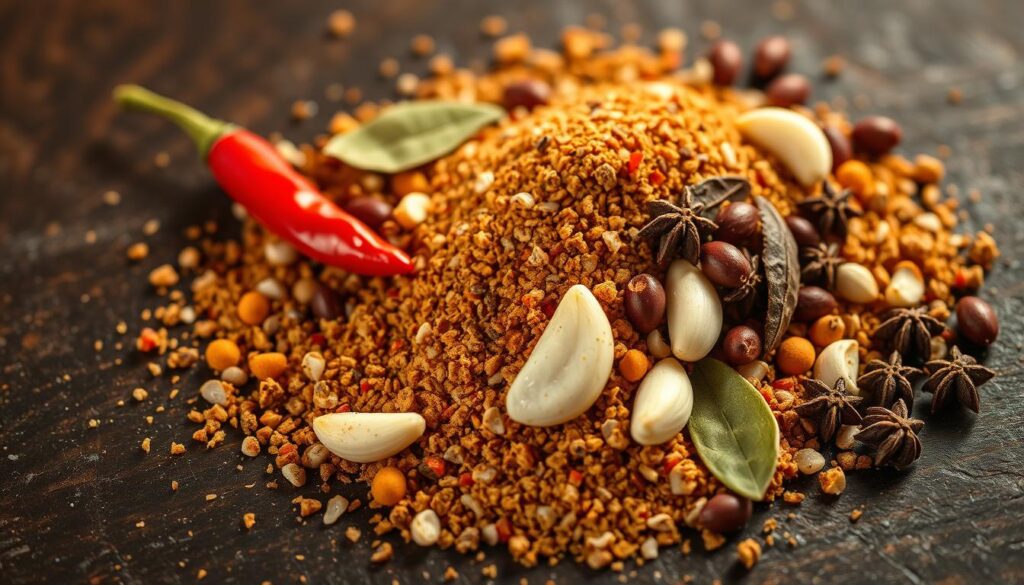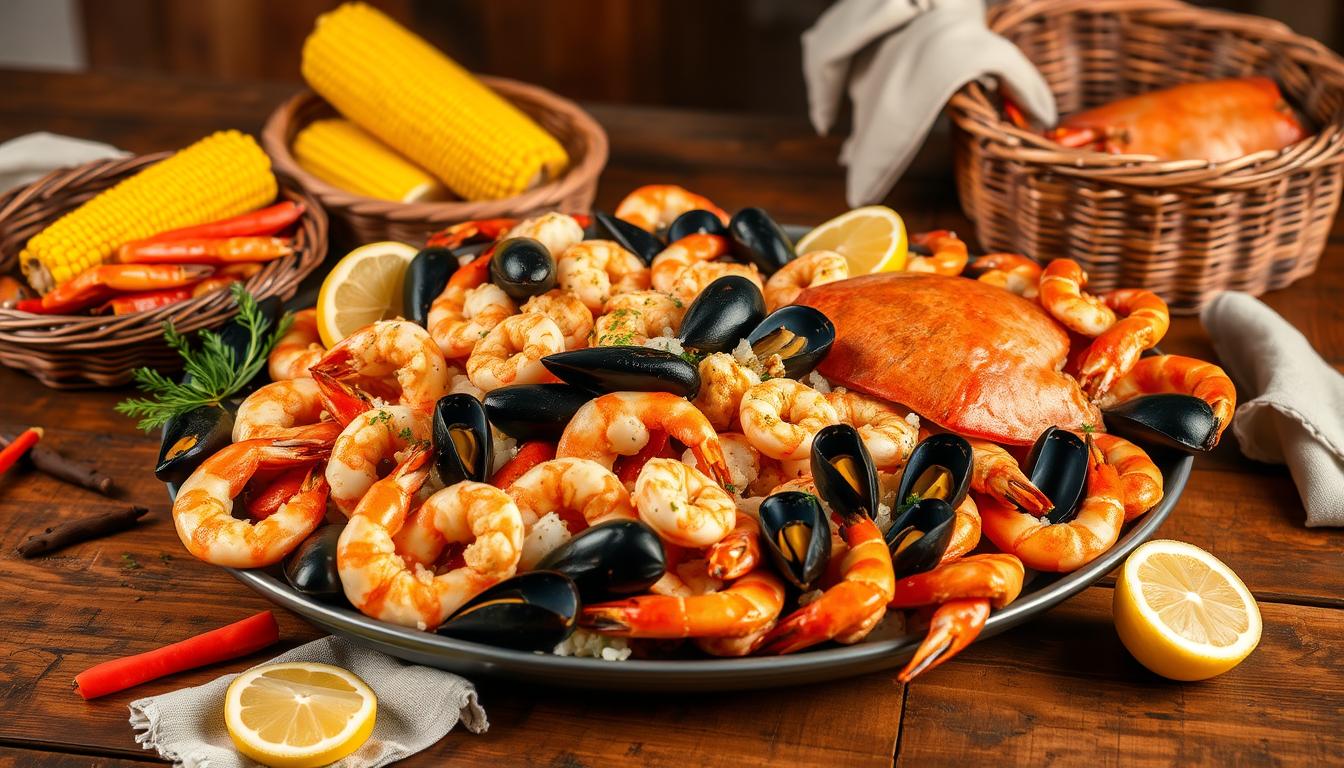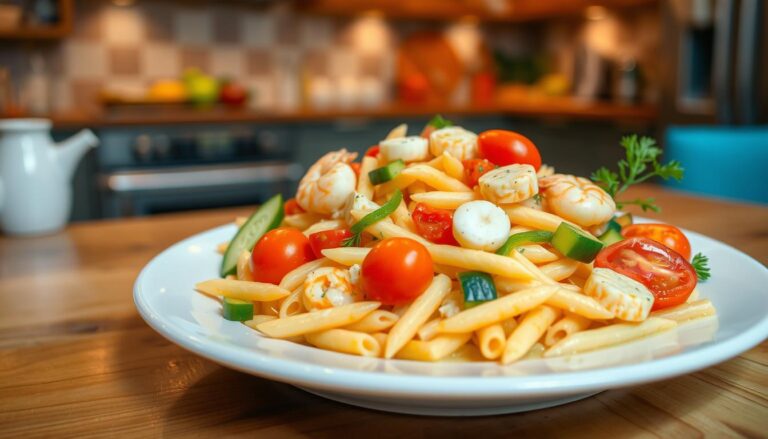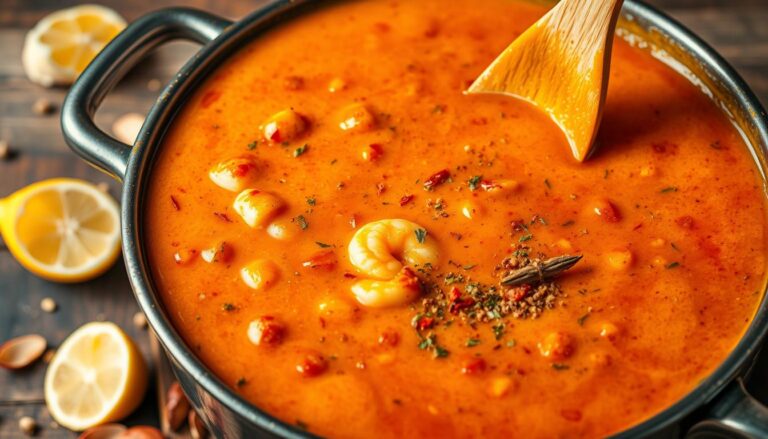Crab Boil Made Easy – A Flavor-Packed Guide for Beginners and Food Lovers
Summer memories come alive with the sound of a seafood boil. It’s that special moment when steam rises and friends gather. They’re all set to enjoy a feast together.
A crab boil is more than just a meal. It’s an experience that brings people together. It turns simple ingredients into a celebration of flavor and connection.
Whether you’re new to cooking or a seasoned food lover, making a perfect seafood boil can seem tough. But don’t worry, this guide will show you how. You’ll learn how to make a crab boil that will wow your friends and family. From picking the freshest seafood to getting the seasoning just right, we’ve got you covered.
Crab boils are more than cooking. They’re a tradition that shows the joy of eating together. We’ll break it down step by step. You’ll learn how to make a seafood boil that will have everyone wanting more.
Table of Contents
Key Takeaways
- Discover the joy of creating a delicious crab boil at home
- Learn essential techniques for preparing seafood perfectly
- Understand the cultural significance of seafood boils
- Master seasoning and cooking methods
- Transform your cooking skills with a memorable dining experience
Understanding the Seafood Boil Tradition
Seafood boils are a lively tradition in American coastal areas. They turn simple ingredients into unforgettable meals that unite people. It’s not just a meal; it’s a celebration of local tastes and cultural heritage.
Origins of Seafood Boils
The crab boil started in coastal areas where fishing communities cooked together. They found boiling seafood with strong seasonings made tasty, easy meals. Native American and European settlers added their own cooking styles, making it unique.
- Developed by coastal fishing communities
- Rooted in practical cooking traditions
- Influenced by diverse cultural cooking methods
Regional Variations and Styles
Coastal areas in the U.S. have their own seafood boil styles. The Lowcountry boil in South Carolina has shrimp, sausage, and corn. Louisiana’s Cajun crab boil is known for its bold spices and crawfish, showing the state’s rich food culture.
Cultural Significance in American Cuisine
A seafood boil is more than food; it’s a way to connect communities. Whether it’s a backyard party or a beach celebration, these meals create memories. The tradition keeps growing, bringing people together through food and local flavors.
“A seafood boil is a celebration of community, flavor, and tradition.” – Coastal Cooking Magazine
Essential Ingredients for the Perfect Crab Boil
To make a seafood boil recipe that stands out, start with the right ingredients. Choose fresh, high-quality items that blend together for a delicious meal.
- Fresh seafood (crab legs, shrimp)
- Hearty vegetables
- Flavorful proteins
- Signature seasonings
Here’s what you need for your seafood boil:
| Ingredient Category | Recommended Options | Flavor Profile |
|---|---|---|
| Seafood | Snow crab, King crab, Blue crab | Sweet, delicate |
| Vegetables | Corn on the cob, Red potatoes | Starchy, complementary |
| Proteins | Andouille sausage, Kielbasa | Spicy, smoky |
| Seasonings | Old Bay, Cayenne pepper, Garlic | Bold, zesty |
When you’re making your crab boil, freshness is key. Pick seafood that smells good and looks fresh. Your local fishmonger can guide you to the best seafood.
“A great crab boil is about balance – each ingredient should shine while complementing the others.” – Coastal Cuisine Expert
Pro tip: Feel free to try new things in your seafood boil. While classic ingredients are great, your unique twist can make it unforgettable.
Choosing and Preparing Your Seafood
Starting a crab boil means picking the best seafood. Fresh, quality crabs and shellfish make your shrimp crab boil unforgettable.
Before you start, learn about selecting, storing, and preparing seafood. The quality of your ingredients affects the taste and fun of your meal.
Selecting Fresh Crab Types
Crabs come in different flavors for your boil. Here are some favorites:
- Blue Crabs: Sweet meat, loved in the Chesapeake Bay
- King Crabs: Big, meaty, and full of flavor
- Snow Crabs: Soft texture, great for boils
Proper Storage and Handling
Seafood freshness depends on how you store it. Keep live crabs cool and moist, around 50°F. Don’t use fresh water, as it harms them.
Cleaning and Preparation Techniques
Here’s how to clean crabs for your boil:
- Rinse crabs under cold water
- Take out gills and the intestinal area
- Pat dry with paper towels
Follow these steps for a crab boil full of fresh, tasty seafood. Your guests will love it.
The Ultimate Crab Boil Seasoning Guide
Making the perfect crab boil starts with a great seasoning blend. This blend turns simple seafood into a feast for the senses. Your seasoning is the key to unlocking the natural flavors of fresh seafood, making your dish a hit with all.

To make a top-notch cajun seafood boil sauce, you need to master spice blending. A great crab boil seasoning has a mix of spices that work together beautifully:
- Cayenne pepper for heat
- Paprika for depth of flavor
- Garlic powder for aromatic intensity
- Black pepper for sharp notes
- Old Bay seasoning for traditional seafood kick
With your own spice blend, you can adjust the heat and flavor to your liking. Begin with a balanced mix and tweak it as needed. A pro tip: Toasting whole spices before grinding brings out richer, more complex flavors that will make your crab boil unforgettable.
“The right seasoning turns a simple seafood dish into a culinary masterpiece.” – Southern Cooking Wisdom
When making your cajun seafood boil sauce, mix your dry spice blend with butter, lemon juice, and fresh herbs. This method creates a sauce that’s both rich and vibrant, enhancing the crab meat’s natural sweetness.
Keep your custom crab boil seasoning in an airtight container in a cool, dark spot. This keeps the flavors strong. With these tips, you’ll be all set to host a seafood feast that everyone will love!
Step-by-Step Cooking Method
Mastering a delicious crab boil needs precision and technique. Your seafood boil recipe will come to life with the right cooking approach. This ensures every bite is full of flavor and perfectly cooked.
Preparing a successful seafood boil is an art. It combines timing, temperature, and ingredient selection. Let’s break down the essential steps to create a mouthwatering crab boil that will impress your guests.
Preparing the Boiling Liquid
The foundation of any great crab boil starts with a flavorful liquid base. You’ll want to create a robust broth that infuses your seafood with rich, zesty flavors. Consider these key ingredients:
- Water or seafood stock
- Old Bay seasoning
- Fresh lemon wedges
- Garlic cloves
- Bay leaves
Timing and Temperature Control
Precision is crucial when cooking a seafood boil recipe. The ideal cooking time typically ranges from 30-45 minutes. You need to pay close attention to temperature and ingredient cooking rates.
“The secret to a perfect crab boil is knowing exactly when to add each ingredient and how long to cook it.” – Coastal Cooking Experts
Adding Ingredients in the Right Order
Your crab boil success depends on adding ingredients strategically. Start with hardier ingredients and progress to more delicate seafood:
- Potatoes and corn (15-20 minutes)
- Sausage (10-12 minutes)
- Crab and other shellfish (5-8 minutes)
- Shrimp (2-3 minutes)
Pro tip: Use a large pot or outdoor propane burner. This ensures even heat distribution and maintains the perfect boil throughout the cooking process.
Pairing Vegetables and Additional Ingredients

A great seafood boil is more than just seafood. The right vegetables and ingredients can make your shrimp crab boil a complete, delicious meal. It will satisfy everyone at the table.
Classic vegetables can add amazing flavors and textures to your seafood boil. Here are some traditional choices:
- Corn on the cob (sweet and perfectly charred)
- Red potatoes (absorbing all the delicious broth)
- Whole onions (adding depth and sweetness)
- Garlic cloves (for an extra flavor punch)
For those who like to try new things, here are some unique vegetables:
- Artichoke hearts
- Mushrooms
- Brussels sprouts
- Cauliflower florets
Protein lovers can add sausage to their seafood boil. Andouille sausage adds a spicy Cajun kick that goes well with seafood. Sliced into bite-sized pieces, it adds richness and texture.
Pro tip: Add vegetables in stages based on their cooking times. Potatoes and harder vegetables go in first. Quick-cooking items like corn should be added near the end to prevent overcooking.
Serving and Presentation Tips
A crab boil is more than just a meal—it’s an experience that brings people together. The right presentation can turn your seafood boil into an unforgettable event.
When serving your seafood boil, use newspaper or butcher paper on your table. It makes cleanup easy and adds to the authentic feel.
Essential Table Setting Tools
- Crab crackers
- Seafood picks
- Disposable bibs
- Large communal platters
- Wet wipes or hand towels
Delicious Dipping Sauces
| Sauce Name | Key Ingredients | Flavor Profile |
|---|---|---|
| Classic Garlic Butter | Melted butter, minced garlic, parsley | Rich and savory |
| Spicy Cocktail Sauce | Ketchup, horseradish, hot sauce | Tangy and spicy |
| Cajun Remoulade | Mayonnaise, Creole mustard, capers | Zesty and complex |
Beginner’s Eating Techniques
Cracking crab shells can seem hard for beginners. Start by breaking the shell with your crab cracker. Then, use a seafood pick to get the meat. It’s okay to get messy—it’s all part of the fun!
Remember, a crab boil is a social event. Encourage sharing, laughter, and enjoying the experience together. Your guests will love the relaxed and interactive dining atmosphere you’ve created.
Storing and Reheating Leftovers
After enjoying a delicious seafood boil recipe, you’ll want to preserve those mouthwatering flavors for later. Proper storage is crucial for maintaining the quality of your crab boil and ensuring food safety.
Your crab boil leftovers can stay fresh in the refrigerator for 3-4 days when stored correctly. Follow these essential tips to keep your seafood at its best:
- Cool seafood quickly before refrigerating
- Store different components separately
- Use airtight containers
- Keep refrigeration temperature below 40°F
Reheating requires gentle care to prevent overcooking. Pro tip: Steam your seafood instead of microwaving to maintain its tender texture.
| Storage Method | Duration | Best Practices |
|---|---|---|
| Refrigerator | 3-4 days | Use shallow containers, cover tightly |
| Freezer | Up to 3 months | Wrap in freezer-safe packaging |
“Fresh seafood is a treasure—treat your leftovers with respect!” – Coastal Cooking Experts
Creative cooks can transform leftover crab boil into exciting new dishes like seafood chowder or crab cakes. Always trust your senses: if something smells off, it’s best to discard it.
Conclusion
Your journey into crab boils has given you the skills to make unforgettable meals. A seafood boil is more than cooking; it’s about sharing moments and making memories. You now know how to turn a simple meal into a lively celebration.
Crab boils are incredibly versatile. You can mix and match seasonings, seafood, and veggies to your liking. Whether it’s a family dinner or a party with friends, you can impress everyone with your cooking.
Cooking is all about exploring and expressing yourself. Each crab boil you make will be special, showing off your creativity. Feel free to try new spices and ingredients. The most important thing is the joy and connection you share at the table.
As you get better at making crab boils, you’ll see it’s more than just food. It’s a way to bring people together, make lasting memories, and celebrate American cuisine. Enjoy the journey, relish every moment, and savor the flavors.


